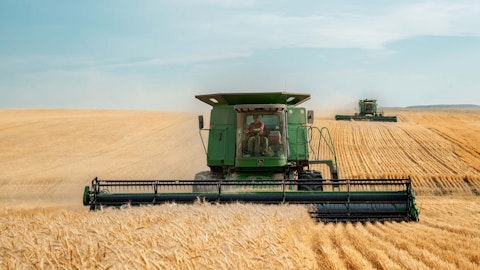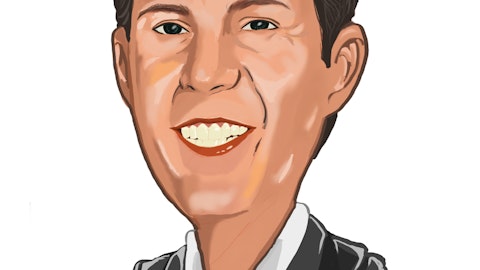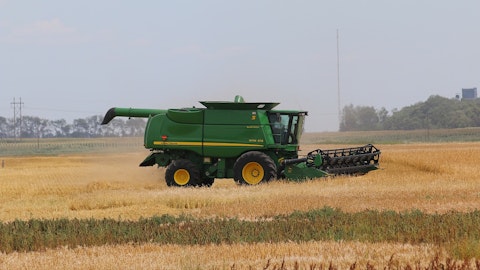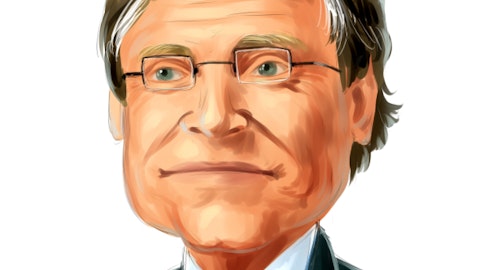Deere & Co (NYSE:DE) Q3 2022 Earning Call Transcript November 23, 2022
Deere & Co beats earning expectations. Reported EPS is $7.44, expectations were $7.11.
Operator: Good morning, and welcome to Deere & Company’s Fourth Quarter Earnings Conference Call. Your lines have been placed on a listen-only mode until the question-and-answer session of today’s conference. I would now like to turn the call over to Mr. Brent Norwood, Director of Investor Relations. Thank you. You may begin.
Brent Norwood: Hello. Also on the call today are John May, Chairman and Chief Executive Officer; Josh Jepsen, Chief Financial Officer; and Rachel Bach, Manager of Investor Communications. Today, we’ll take a closer look at Deere’s fourth quarter earnings, then spend some time talking about our markets and our current outlook for fiscal year 2023. After that, we’ll respond to your questions. Please note that slides are available to complement the call this morning. They can be accessed on our website at johndeere.com/earnings. First, a reminder, this call is being broadcast live on the Internet and recorded for future transmission and use by Deere & Company. Any other use, recording or transmission of any portion of this copyrighted broadcast without the express written consent of Deere is strictly prohibited.
Participants in the call, including the Q&A session, agree that their likeness and remarks in all media may be stored and used as part of the earnings call. This call includes forward-looking comments concerning the company’s plans and projections for the future that are subject to important risks and uncertainties. Additional information concerning factors that could cause actual results to differ materially is contained in the company’s most recent Form 8-K and periodic reports filed with the Securities and Exchange Commission. This call also may include financial measures that are not in conformance with accounting principles generally accepted in the United States of America, GAAP. Additional information concerning these measures, including reconciliations to comparable GAAP measures, is included in the release and posted on our website at johndeere.com/earnings under Quarterly Earnings & Events. I will now turn the call over to Rachel Bach.
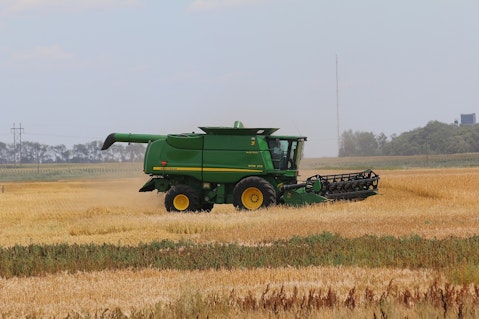
Pixabay/Public Domain
Rachel Bach: Good morning. John Deere finished the year with a strong fourth quarter, thanks to a 40% increase in net sales. Financial results for the quarter included an 18.5% margin for the equipment operations. Across our businesses, performance was driven by continued strong demand, higher production rates and progress on reducing our inventory of partially completed machines. Looking ahead, ag fundamentals remain positive, continuing to drive healthy demand as evidenced by our order books full into the third quarter of fiscal year 2023. The construction and forestry markets also continued to benefit from solid demand contributing to the division’s notable performance in the quarter. Similarly, order books are extended into the second half of ’23, providing visibility and confidence in the new fiscal year.
Slide 3 shows the results for fiscal year 2022. Net sales and revenues were up 19% to $52.6 billion, while net sales for the equipment operations were up 21% to $47.9 billion. Net income attributable to Deere & Company was $7.1 billion or $23.28 per diluted share. Next, fourth quarter results are on Slide 4. Net sales and revenues were up 37% to $15.5 billion, while net sales for the equipment operations were up 40% to $14.4 billion. Net income attributable to Deere & Company was $2.2 billion or $7.44 per diluted share. Let’s take a closer look at fourth quarter results by segment, beginning with our production and precision ag business on Slide 5. Net sales of $7.434 billion were up markedly at 59% compared to the fourth quarter last year. This was primarily due to higher production rates both year-over-year and sequentially.
Additionally, we made progress on clearing partially completed machines from inventory. Both contributed to higher shipment volumes for the quarter. Price realization in the quarter was positive by about 19 points, whereas currency translation was negative by about 3 points. Operating profit was $1.74 billion, resulting in a 23.4% operating margin for the segment. The year-over-year increase in operating profit was primarily due to higher shipment volumes and price realization, partially offset by higher production costs and higher SA&G and R&D spend. Operating profit for the quarter was negatively impacted by higher reserves on the remaining assets in Russia, affecting the quarter’s margin by about 1 point. The production costs were mostly elevated material and freight Overhead spend was also higher for the period as factories continue to experience some production inefficiencies due to supply challenges and clearing of partially completed machines in inventory.
Despite these headwinds, our factories were able to maintain higher rates of production and reduce the number of partially completed machines in inventory, allowing us to deliver more equipment to our dealers and customers. Moving to small ag and turf on Slide 6.Net sales were up 26%, totaling $3.544 billion in the fourth quarter due to higher shipment volumes and price realization, which more than offset negative currency translation. Price realization in the quarter was positive by nearly 13 points, while currency translation was negative by over 6 points. For the quarter, operating profit was higher year-over-year at $506 million, resulting in a 14.3% operating margin. The increased profit was primarily due to price realization and improved shipment volumes and mix.
These were partially offset by higher production costs, higher R&D and SA&G expenses and unfavorable currency impacts. Please turn to Slide 7 for the fiscal year 2023 ag and turf industry outlook. We expect large ag equipment industry sales in U.S. and Canada to be up 5% to 10%, reflecting resilient demand that continues to be higher than the industry’s ability to supply, bolstered by the need to replace aging fleets. Our order books now extend into the third quarter and the dealers remain on allocation for ’23. For small ag and turf, industry demand is estimated to be flat to down 5%. The dairy and livestock segment remain steady. However, demand for products more correlated to the general economy, such as compact utility tractors and turf equipment is softening.
Shifting to Europe. The industry is forecast to be flat to up 5%. Farm fundamentals in the region are generally stable since small grain prices continue to outpace input inflation. Meanwhile, supply constraints in 2022 are extending the equipment replacement into 2023. In South America, we expect industry sales of tractors and combines to be flat to up 5%, moderated by supply chain constraints. The region remains one of the stronger end markets, especially in Brazil, where they are forecasting record production and strong profitability for the year. Industry sales in Asia are projected to be down moderately as India, the world’s largest tractor market by unit stabilizes after record highs in 2021. Turning now to our segment forecast on Slide 8. We anticipate production and precision ag net sales to be up between 15% and 20% in fiscal year ’23.
The forecast assumes approximately 11 points of positive price realization and 1 point of negative currency translation. For the segment’s operating margin, our full year forecast is between 22% and 23%. Slide 9 shows our forecast for the small ag and turf segment. We expect fiscal year ’23 net sales to be flat to up 5%. This guidance includes about 7 points of positive price realization, partially offset by 2 points of unfavorable currency impact. After accounting for the effects of price and FX, the guide implies a slight volume decrease due to softening in certain product segments. The segment’s operating margin is projected to be between 14.5% and 15.5%. Turning to construction and forestry on Slide 10, price realization and higher shipment volumes both contributed to a 20% increase in net sales for the quarter to $3.373 billion. Price realization in the quarter was positive by nearly 13 points. This was partially offset by almost 5 points of negative currency translation. Operating profit increased to $414 million, resulting in a 12% operating margin. Favorable price realization and higher shipment volumes more than offset higher production costs during the quarter.
Segment quarterly results were also negatively impacted by 1.5 points of margin due to higher reserves on the remaining assets in Russia. Now I’ll cover our 2023 construction and forestry industry outlook on Slide 11. Industry sales of both earthmoving and compact construction equipment in North America are expected to be flat to up 5%. End markets overall are expected to remain steady as oil and gas, U.S. infrastructure spend and CapEx programs from the independent rental companies offset moderation in the residential sector. Global forestry markets are expected to be flat as stronger European demand continues to be limited by the industry’s ability to produce and demand in North America begins to subdue. Global roadbuilding markets are also expected to be flat. Demand remains strongest in the Americas, while Europe is softening and Asia remains sluggish.
Our C&F segment outlook is on Slide 12. 2023 net sales are forecasted to be up around 10%. Our net sales guidance for the year includes about 8 points of positive price realization and just over 1 point of negative currency translation. The segment’s operating margin is projected to be 15.5% to 16.5%. Note, fiscal year ’22 operating margin would have been 14.5%, excluding special items, such as the onetime gain from the remeasurement of the Deere-Hitachi assets.
Let’s transition to our financial services operation on Slide 13.Worldwide financial services net income attributable to Deere & Company was slightly higher in the fourth quarter year-over-year, mainly due to income earned on a higher average portfolio, partially offset by less favorable financing spreads. The provision for credit loss increased, reflecting economic uncertainty in Russia. Financial services received an intercompany benefit from the equipment operations, which guarantees investments in certain international markets, including Russia. For fiscal year 2023, the net income forecast is $900 million.
Results are expected to be slightly higher year-over-year primarily due to income earned on a higher average portfolio. The portfolio has continued to grow in line with growth in the equipment operations. Overall, Financial Services is expected to continue to deliver steady results. Credit loss provisions, lease return rates and past dues all remain in good shape, reflecting sound balance sheets for our customers. Slide 14 outlines our guidance for net income, our effective tax rate and operating cash flow. For fiscal year ’23, our full year net income forecast is a range of $8 billion to $8.5 billion. We expect favorable price realization and higher volumes to more than offset increased spend. Next, our guidance incorporates an effective tax rate between 23% and 25%.
And lastly, cash flow from equipment operations is projected to be between $9 billion and $9.5 billion. Before we transition to Q&A, John, I’d like to thank you for joining us today.
See also 14 Best Agriculture Stocks to Buy Now and 12 Best Climate Change Stocks to Invest In.
John May : Yes. Thanks, Rachel. First, I want to recognize all of our dedicated employees, dealers and suppliers. Fiscal year 2022 was another unprecedented year in several ways. We started the year in a work stoppage at some of our largest U.S. factories, but we resolved that with a groundbreaking industry-leading new contract, then supply and logistics hurdles created disruption and constrained our production worldwide. At times, deliveries were delayed as demand simply outstripped what the industry could supply. Our operations folks worked tirelessly to get equipment shipped to our dealers and customers. The team overcame disruptions from part shortages and delays to the clearing of partially completed machines to meet our customers’ needs.
In the last half of the year, and particularly here in the fourth quarter, we executed to our plans, saw a substantial lift in production and outpaced the industry production and retail sales. This resulted in our highest revenue and margin quarter for the year. It proves what we’ve known all along, that we’ve got the best factory teams in the industry, and I’m extremely proud of their efforts and resilience. As I look ahead to fiscal year 2023 and beyond, I truly believe our best years are still ahead of us. In the near term, order books across our businesses are full into the third quarter. And it’s important to note that not only do the order books continue to fill when we open them, but the velocity of orders has remained strong. We opened North American combined EOP back in August.
Like our crop care EOP, it was on an allocations but it filled in 2 months. That’s noteworthy because we normally have the EOP open for five to six months. And since our order books are still on allocation for retail sales, we have yet to begin replenishing dealer inventory. And as we continue to make progress on our Smart Industrial strategy and Leap Ambitions, I’m even more confident and our ability to unlock immense value for our customers. When you integrate the industry’s best equipment with cutting-edge technology and a world-class dealer channel, it’s powerful and it’s exciting. We already have solutions in fields and on work sites, and we are bringing more solutions to the market that will make our customers a lot more productive, a lot more profitable and help them do the jobs they do in a much more environmentally sustainable way.
Rachel Bach: Great. Thanks, John. Now we know there are some — likely some common topics of interest, so let’s dig into those before opening the line for Q&A. First, I’d like to take some time to look more closely at the macro environment and some of the fundamentals for each of our segments. Let’s start with production and precision ag. We’re forecasting the industry to be up 5% to 10%. Brent, there’s a lot going on there in terms of what is driving that growth. Can you unpack a little for us?
Follow Deere & Co (NYSE:DE)
Follow Deere & Co (NYSE:DE)
Brent Norwood: Sure. There’s a few things going on I’d like to point out, Rachel. Stocks-to-use ratios for key grains still remain very, very low, while exports from the Black Sea region are expected to be down about 40%. So it’s going to take a couple of growing seasons to ease the tight supply and this should help support commodity prices in the interim. While crop prices may have come down a little bit since the summer, they remain at levels where our customers still have healthy profits despite some of the higher input costs they’re facing. Finally, the industry has not been able to meet demand due to supply chain constraints and demand continues to outpace supply. And we see that in how quickly our order books fill up and historically low dealer inventory of both new and used equipment. It’s also evident in the fleet age, which is well above average.
Rachel Bach: All right. So fundamentals remain solid, but weather, geopolitical tensions and broader economic conditions may be weighing on our customers’ minds.
Brent Norwood: Yes, that’s absolutely true, Rachel, and we recognize that. But our order books really serve as the best indicator though. Not only are they extending into the third quarter of 2023, but the velocity in which they fill remains really encouraging for us. Recall that our order books are still on an allocation basis when those orders ship, they generally retail right away and almost all of those machines have a customer’s name on them when they go down the production line. Remember that our dealer inventories still need to be replenished. Four-wheel drive inventory to sales ratios are at 10%, while 220-plus horsepower tractors are at 12%. And those numbers might even be a little bit overstated because our dealers are working through all of those fourth quarter shipments right now, and they’re still delivering them to customers.
Also of note, our guidance does assume that we build to retail demand. So any dealer inventory replenishment will likely be pushed to 2024. Additionally, I would like to point out that the 2023 North America large ag volumes will be 20% to 25% lower than the five-year average volume from the 2010 to 2014 replacement cycle. This is clear if you look at the AEM data our revenues are higher because we’ve increased our value per machine for our customers through precision ag solutions. But volumes are still rather modest when compared to the entire replacement period of that five years of 2010 to 2014.
John May: Yes, Brent, I have a few things to add here. This last year, I’ve been out meeting with dealers on a regular basis. And I often hear them telling me that they’re not able to quote every customer who wants to place an order because we’re still constrained by the supply base and on an allocation basis. So clearly, more demand — there’s more demand for our equipment. And this replacement cycle will have an extended duration. I am confident we will produce more large ag equipment in 2023 than we did in 2022, and not just more equipment but more value per machine. Our production system approach has us laser-focused on the customer and unlocking more value for them. This will increase the value per machine even more.
Rachel Bach: All right. Let’s move on now to small ag and turf. This division has the most diverse end markets of any of our segments. Josh, can you elaborate more on how we’re viewing those different markets?
Josh Jepsen: Sure. There are definitely different macro drivers when you break down the segment a bit further. If we begin with small ag, supply of meat and dairy products has remained tight, which has helped prices remain elevated. And as a result, livestock and dairy margins remain above historical averages. Additionally, dealer inventory to sales ratios for midsized tractors are below levels — below normal levels as demand has continued to outstrip supply. So this part of SAT has remained stable and resilient. A good proof point here is that the order book for our midsized tractors built in Mannheim, Germany is about 70% full, taking us well into the third quarter of fiscal ’23.On the other hand, turf and utility equipment as well as compact utility tractors are more closely correlated to the general economy and somewhat specifically to housing.
So we’ve seen some softening there. Channel inventory remains low, especially for turf, buffering our shipments to some extent. But we’re monitoring inventory closely so that we can react if demand pulls back and forth. We don’t intend to let inventory climb to pre-pandemic levels here.
Rachel Bach: All right. That’s helpful. Thanks, Josh. Let’s shift now to C&F. The last few years of demand were largely driven by housing. So how is that segment housing starts. Brent, can you talk through that?
Brent Norwood : You bet, Rachel. So on one hand, we have seen some softening in housing while non-res building projects have continued to decline a little bit. On the other hand, oil and gas CapEx has been very steady with rig counts projected to be up next year. And U.S. infrastructure is beginning to show some promise going into 2023, which is especially important for Wirtgen. In addition to that, both dealer-owned rental channel and the independent players have significant refleeting programs going into 2023. So all in all, we’re seeing a shift in the composition of demand drivers for that business, less housing, but more than offset by rental infrastructure and oil and gas.
John May : Brent, I’d like to add that C&F dealer inventory, as with other parts of our business is historically low and needs to be replenished but we’re currently focusing on retail demand and our order books are close to 70% full.
Rachel Bach: All good insight into the various industries and market dynamics and it’s all factored into our net sales guidance for the full year. To recap, common themes across our businesses, our order books are strong, but still on allocation. We’re focused on meeting pent-up retail demand, and we still need to replenish channel inventory possibly late 2023, but more likely into 2024. Brent, can you talk about what all this means for our ’23 production schedule?
Brent Norwood : Sure. So this past year, we did not have our normal seasonality. And we had the work stoppage at the beginning of the first quarter, and we had experienced the worst of the supply chain issues as we tried to ramp up more during the second quarter. So we played catch up later in the year, resulting in a significantly more back half-weighted 2022.In fact, we ended up producing more in each successive quarter throughout the year with the fourth quarter being the high point. We achieved our highest daily production rates in the fourth quarter, and we plan to keep those higher daily rates going into the first quarter of 2023.Now while line rates remain at those higher levels, there will be some key differences in sequential revenue though.
First, there are about 15% less production days in the first quarter due to the holiday season. So expect revenue for small ag and turf and C&F to drop by about 15% sequentially in the first quarter of 2023 when compared to the fourth quarter of 2022.Our PPA factories will have another 5% to 10% fewer production days due to some model year changeovers, maintenance, training and supplier recovery. So in total, production and precision ag production time will decrease by 20% to 25% in the first quarter compared to the fourth quarter of 2022. Now also keep in mind that PPA benefited from clearing about $400 million of partially completed machines from inventory in the fourth quarter. So that benefit won’t repeat in the first quarter. So we likely won’t get back to a similar level of 4Q revenue until the second quarter of 2023.
John May: Yes. This is John. Brent, I want to reiterate something you said while sequentially, the first quarter compared to the fourth quarter will be lower, however, year-over-year production will be higher in the first quarter. We aren’t starting the year out behind, so we’ll have more production in the first half of 2023 than we did in the first half of 2022.
Rachel Bach: That’s helpful. Let’s switch gears now to the supply chain. We’ve taken steps to try to mitigate risk, but the supply base remains fragile. We do see pockets improving, but at a slow pace and certainly not to pre-pandemic levels that we would consider to be a healthier supply chain. So our guide does not assume significant improvement or deterioration in 2023. Josh, can you elaborate on our production costs included in the forecast?
Josh Jepsen: As it relates to production costs in ’23, there are a few puts and takes. Certain raw materials like hot-rolled coil steel are easing, as you can see in some of the different indices. Also, we expect the need for premium freight to subside next year. On the other hand, labor and energy costs will increase. That’s not only impacting us directly but also our suppliers, so we continue to see increased cost for purchase components as well. Additionally, as you mentioned, we’re seeing pockets of improvement in the supply chain, but it remains fragile. So we’re not assuming that our operations return to normal levels of productivity and efficiency in our forecast. With the different ups and downs, our guide assumes a net increase in production costs in 2023, but we fully expect this to be offset by price realization and anticipate the full year being price production cost positive.
Rachel Bach: Thank you for that. And before we open the line for other questions, Josh, can you talk briefly about the use of cash priorities and capital allocation in 2023?
Josh Jepsen: Sure. Simply put, they remain unchanged. We’re happy with our liquidity position to maintain our single A credit rating and fund our business. Our guide considers an increase in R&D and CapEx as we continue to progress on strategic projects building upon the tech stack and unlocking more value for our customers. Next, the dividend. We increased it 8% in fiscal year ’22. And it’s worth noting that over the last two years, we’ve increased it nearly 50%. Finally, share repurchase. We purchased over $1 billion of shares in the fourth quarter for a total of $3.6 billion for fiscal year ’22, and we have an opportunity to continue that trajectory heading into fiscal ’23. So all in all, we’re in a great position to grow our business execute on our Leap Ambitions and continue to return cash to shareholders.
Rachel Bach: Thanks, Josh. Brent, let’s see what other questions our investors have.
Brent Norwood: Now we are ready to begin the Q&A portion of the call. The operator will instruct you on the polling procedure. In consideration of others and our hope to allow more of you to participate in the call, please limit yourself to one question. If you have additional questions, we ask that you re-join the queue.
Operator: Our first question comes from Tim Thein of Citigroup.
Tim Thein: Maybe just circling back, Josh, on your comments there as to the full year, the expectations for price to be in excess of production costs. Obviously, a lot going on from a year-over-year standpoint just given how the comps kind of will play out, is there any more kind of help that you can give in terms of — does that — would you expect that spread to grow as we move through the year and thus the margin benefit is more back-half weighted or maybe not just because of how costs are trending? Maybe just any more kind of more on a quarterly basis, any more help you can give on that?
Brent Norwood : Tim, this is Brent. Thanks for the question. As we look out to next year, we probably see a little bit of a different quarterly cadence than what you experienced in 2022.If I do a look back on this last year, we saw our most challenging price/cost quarters in the first half of the year. In fact, that compare got better as we got through each of the quarters with the fourth quarter being the most positive from a price relative to production cost perspective. As we look out to 2023, I think you’ll see a very different cadence there. We intend to be price/cost positive on a much more even basis throughout all of the quarters. You’ll probably see the strongest price performance for us really earlier in the year just as the compares are most favorable.
And then in the back half of the year as some of those price compares get a little harder production cost compares maybe get a little bit easier in the back half of the year. So I would expect for next year just more even cadence throughout the course of the year as we compare price to overall production cost.
Josh Jepsen : Tim, one other thing. I mentioned this earlier in the prepared comments, but we have not forecast a return to normal productivity and efficiency in our factories. So as it relates to the overhead in efficiencies we saw in ’22. To the extent we see more stability in supply chain, the ability to operate more in line with our plans through the year. There could be some benefit there. But at this point, we haven’t pulled that into the forecast. We need to see that stability first.
Operator: Our next question comes from Seth Weber of Wells Fargo Securities.
Seth Weber: Josh, I think you mentioned the $400 million of inventory that you cleared in the fourth quarter. Can you just frame for us what’s still to come? I mean, is first quarter like an equivalent amount? And do you expect that to be largely done by, call it, the first half? Or just how should we be thinking about the inventory that’s kind of sitting around waiting for parts or materials?
Brent Norwood: We have made a lot of progress on the partially completed machines. We’ve had in inventory since the second quarter. That’s really where we saw that figure peak. We took down about 1/3 of that over the course of the first quarter, and then we took another $400 million down in the fourth quarter. I would say the level of partially completed inventory within the system right now is running at a much more normalized level. I mean there’s always some level of partially completed machines kind of within our working capital system. So it’s much more normalized right now. The benefit that you saw in the fourth quarter is not going to repeat in the first quarter really at any other time, I think, in 2023, assuming we don’t build more inventory of partially completed machine. So I would say, by and large, the tailwind from that has largely been completed in the fourth quarter.
Josh Jepsen : Yes, Seth, this is Josh. Maybe importantly, too, our intent in our factories is to not have partially completed machines and build and have to take things offline and bring them back because of the inefficiencies and disruptions that drives. So the intent is to run much more linearly with our plans and not create as much of this rework that has to happen because it does drive a lot of disruption in the factory.
Operator: Our next question comes from Jamie Cook of Credit Suisse.
Jamie Cook: I guess my question was there — you talked about the order book being full through the third quarter. Was there any difference by geography within large ag? And sort of when do you expect to open the order book up again so that you’ll have visibility through the visibility through the full year? And then my second question, sorry, just on the production in large ag. Given what you said about production in the first half, I’m trying to think about the second half of the year. Does that imply just with your sales forecast by the fourth quarter sales could be down a little marginally just based on my back of the envelope math, but just trying to understand production cadence.
Brent Norwood: Jamie, thanks for the question. I’ll start on the order book. As we noted, we’re running about kind of 70% full for next year. It varies a little bit by product line, things like combines were effectively sold out for the entire year. In North America, the tractor order book is, I think, 2/3 full. If I move to Europe, that’s 70% full for Mannheim, 65% pool for combines. So pretty similar, I think, across those two geographies. Brazil is the one that we manage a little bit differently than the other two. We run that at about a three-month window just so that we have a little more flexibility with respect to pricing. That market tends to be a little dynamic with both FX and inflation can change quarter-to-quarter. So we’re holding that order book in a little bit tighter than North America and Europe.
And we’ve been executing that strategy for two years. We’ve been really successful there. I think managing price a little more dynamically in that region. I think going forward, you expect us for the remaining order book that’s left in North America and Europe, to manage it on a rolling six-month window, in front of us. So as we get to the first quarter, we should have pretty good visibility on the rest of the year with just a few slots left available. As it relates to sort of the production cadence in the year. As we noted, first quarter we’ll have just less production days, but we’ll continue at those higher line rates. That will put quite a bit of production in the second quarter to give us a much better start to the first half of the year in ’23 as we had — than we had in ’22, as John noted earlier, probably just maybe a little less than 50% of the production will happen in the first half.
So I think when you look first half, second half, you’re not going to see as big a differential in the splits when you compare it back to 2022.
Operator: Our next question comes from Stephen Volkmann of Jefferies.
Stephen Volkmann : My question is on how we should think about increasing interest rates, both with respect to kind of the impact on your finance company, but also what you’re seeing relative to kind of how customers are reacting to higher financing rates as well?
Brent Norwood : Hey, Steve, good morning. Well, I’ll start with the question on the customer first, and we can talk about John Deere Financial. I think the impact to the customer maybe varies a little bit depending on what customer segment we’re talking about. Historically, the customer segment most sensitive to interest rates, is the customer segment for more of our consumer-facing products. So I think compact utility tractors and turf products tend to be a little more reliant on low interest rate financing. I think what you’ll see as we progress through 2023.You may see a little more discount or incentive spend from the equipment operations on things like rate buy downs, but that’s where we see the most sensitivity historically.
When we look at large ag, interest costs overall are a relatively small portion of their P&L, that’s not to say there’s no sensitivity there, but it tends to be just a little less sensitive than maybe other customer segments that we have. And I think the good news for 2023 is that customer balance sheets are really in incredible shape right now. Over the course of 2022, we actually saw lower penetration rates at John Deere Financial because customers were using more cash to finance that acquisition. So that just speaks to not necessarily their sensitivity to interest rates, but more on just a strong balance sheet position that they’re in going into 2023.From a John Deere Financial perspective, we run a match funded book there.So as our cost of borrowing goes up, that will take the forum and higher cost to our customers.
We tend to manage that book in a way so that you don’t see a lot of spread degradation because we manage those interest rates pretty closely and that match funded book. So I wouldn’t say you’ll see a big impact to profitability there. You’ll see higher interest income and higher interest expense going into 2023.
Operator: Our next question comes from Stanley Elliott of Stifel.
Stanley Elliott : Can you talk a little bit about the road construction business in North America? Obviously, we’ve got a lot of moneys coming IIJA. Do you think that the roadbuilding business gets front loaded on that? Should it be continuous over this period of time when you think about kind of like a five-year plus sort of horizon?
Brent Norwood : Yes, we are we are definitely seeing higher levels of demand in North America for Wirtgen. So if we kind of go across the different geographies, Wirtgen operating in right now, by far and away, the strongest are in North America, followed by South America. Europe is starting to ease a little bit. And to your point, I mean, we’re really just now starting to see the benefit from infrastructure going into ’23. So I think that probably grows for Wirtgen over the course of the year and continues to strengthen that market. Importantly, North America right now is really strong mix for Wirtgen. I think about our manufacturing footprint, which is primarily German based. So the FX rate is actually really favorable for a strong North American market.
John May : Yes. Maybe to add to that, Brent, we just completed the bauma show, and we had really, really strong bauma order activity it was actually higher versus 2019. So the demand is strong and customers are buying new equipment and new technologies in order to serve their customers.
Brent Norwood : Maybe just one other thing to add to that. As we ended 2022, we had the strongest margin performance for Wirtgen that we’ve seen since we’ve owned that business. So we continue to be pleased with the progress of the acquisition and the synergies that we’ve integrated in over time.
Operator: Our next question comes from Tami Zakaria of JPMorgan.
